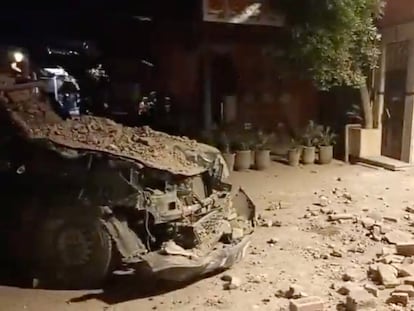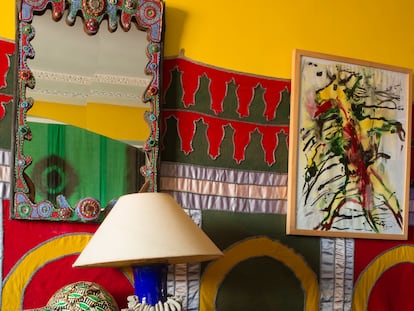Moroccan village of Moulay Brahim removes debris in search of Amina after powerful earthquake
Firefighters and army personnel search for victims among the debris, while hundreds of women and children spent the night outdoors and men set out to provide them with food and water
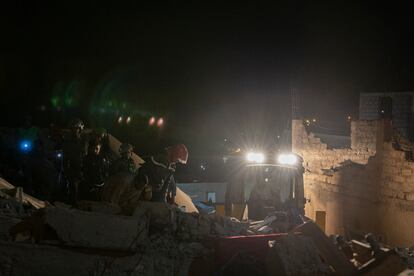
Illuminated by the lights of a small backhoe, a fireman comes out of the small cave formed by the rubble of the house. Dozens of neighbors, all men, witness the scene, oblivious to the danger of the leaning walls of the surrounding buildings. As soon as he gets to his feet, the rescuer turns to one of his colleagues, “Write down, it’s 22:15.″ It has been 23 hours and four minutes since the ground shook in Moulay Brahim (8,000 inhabitants) and rescue teams, accompanied by dozens of volunteers, have just found Amina’s body.
The 35-year-old woman died under the walls of her house along with her four children, but the only bodies left to be found Saturday night under this mass of stones, bricks and scrap iron were hers and that of her youngest son, aged three. Some hundred meters uphill, Amina’s mother waits desperately with other women for news of her daughter and grandson.
“It lasted only five minutes. The earth shook and suddenly everything had collapsed,” says Husein Aitzagut at the door of his home, where he lives with his wife, Rachida, his three-year-old son, Mohamed, his father and two of his sisters-in-law. Those five minutes described by Hussein caused the collapse of dozens of houses and left huge cracks and major structural damage in many others that, in all likelihood, will require their demolition if they do not fall down by themselves first. A total of 28 corpses were recovered from the wreckage on Saturday and were stored at the municipal health center as they were found, while the 45 wounded were transferred to Marrakesh, according to the soldiers coordinating the rescue operations.

After the Covid-19 pandemic, religious tourism had returned to Moulay Brahim, a village perched on a hill at the foot of the Atlas Mountains, lying at an altitude of 1,300 meters and only 50 kilometers from Marrakesh. The Muslim saint bearing the same name is buried there, and thousands of people from all over Morocco visit his mausoleum every year to hold rituals in his honor and to thank him for his promises to get work, to get married, to have children, to recover from illness, to name a few. All the paraphernalia around the saint, the souvenirs, and objects to worship him and the lodgings for renting rooms are what provides food for the population, along with agriculture. The locals believe that visitors will be slow to return now that everything is in ruins.
A walk through its narrow alleys is a dangerous gymkhana that requires you to avoid huge blocks of brick and cement, beams, stones, broken pipes and wires dangling from their poles. All this is under walls and balconies in overhanging cantilevers that are on the verge of collapsing. In the few squares and open places in the village, huge tents have been erected and covered with carpets, where hundreds of women and children are huddled together while the men, who roam from one place to another, are eager to provide help, food, and water.
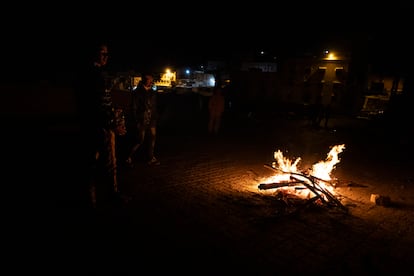




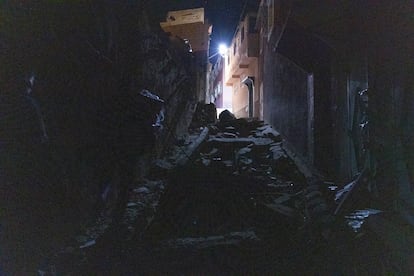

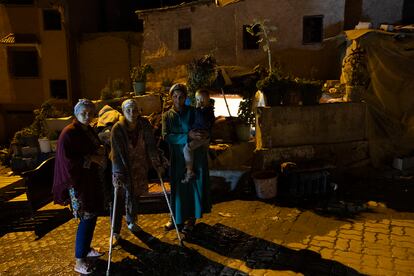
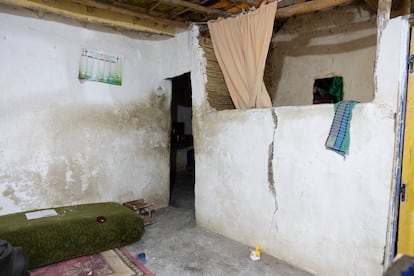
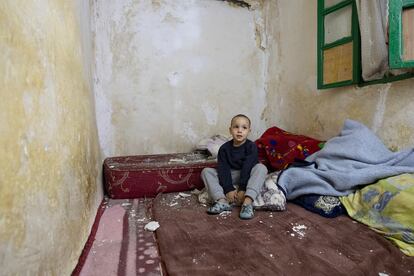

Military, firefighters and medical workers are engaged in the rescue and treatment of the wounded. However, the distribution of food and drink is being carried out by local associations, which are otherwise dedicated to organizing sports, cultural and social activities for the local residents. The president of one of the organizations, Abdullah Ait-Malik, explains how they work in a kind of self-management process in which the men of the village participate. “First, we set up the tents for the women and children. In each one of them, there is a person in charge who is tasked with transferring what they need, and we supply them with it. Then the women do the cooking for everyone.”
Bottles of water, flour, pasta, milk, milk, and cookies
He tells the story in a room packed with bottles of mineral water, flour, pasta, milk, and cookies donated by other groups and people who want to give a helping hand. “The vegetables have just arrived, and we expect bread, meat, and chicken to arrive tomorrow,” adds Abdullah from the door of the organization’s storage unit, whose façade has also collapsed. At the moment, the supplying of the village with large trucks is hampered by the huge stones of up to two meters that have fallen on the winding road that connects it with Marrakesh, about 30 miles down the road.
Night brings the cold, and in the crowded tents the children cling to their mothers under blankets, while the older women stir huge pots over wood fires filled with pasta for dinner. “The authorities have obliged many people not to return to their homes and settle here because of the risk of new landslides, but many other people have decided to settle in the street because they are afraid of a repeat of the earthquake,” explains Husein who, as a precaution, has taken all his belongings out into the street. The families unable to fit in the tents have settled with their mattresses in the fields surrounding the town.
Among the remains of Amina’s house, neighbors scramble to help firefighters pull out her body and continue searching for her son’s. Some do not hesitate to put themselves in danger by going through the wreckage with their cell phone lights to get a better view. Her husband, the sole survivor of the family because he was manning their business during the quake, watches the scene quietly, squatting down. “He is in shock; firefighters have had to restrain him several times throughout the day to stop him from burrowing with his bare hands,” says Yusef Ait, one of his relatives, who came from Marrakesh to offer a helping hand. Now all he can do is console him.

Sign up for our weekly newsletter to get more English-language news coverage from EL PAÍS USA Edition
Tu suscripción se está usando en otro dispositivo
¿Quieres añadir otro usuario a tu suscripción?
Si continúas leyendo en este dispositivo, no se podrá leer en el otro.
FlechaTu suscripción se está usando en otro dispositivo y solo puedes acceder a EL PAÍS desde un dispositivo a la vez.
Si quieres compartir tu cuenta, cambia tu suscripción a la modalidad Premium, así podrás añadir otro usuario. Cada uno accederá con su propia cuenta de email, lo que os permitirá personalizar vuestra experiencia en EL PAÍS.
¿Tienes una suscripción de empresa? Accede aquí para contratar más cuentas.
En el caso de no saber quién está usando tu cuenta, te recomendamos cambiar tu contraseña aquí.
Si decides continuar compartiendo tu cuenta, este mensaje se mostrará en tu dispositivo y en el de la otra persona que está usando tu cuenta de forma indefinida, afectando a tu experiencia de lectura. Puedes consultar aquí los términos y condiciones de la suscripción digital.
More information
Últimas noticias
Most viewed
- Sinaloa Cartel war is taking its toll on Los Chapitos
- Reinhard Genzel, Nobel laureate in physics: ‘One-minute videos will never give you the truth’
- Oona Chaplin: ‘I told James Cameron that I was living in a treehouse and starting a permaculture project with a friend’
- Why the price of coffee has skyrocketed: from Brazilian plantations to specialty coffee houses
- David King, chemist: ‘There are scientists studying how to cool the planet; nobody should stop these experiments from happening’
